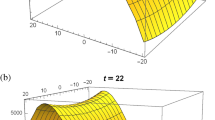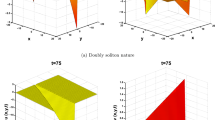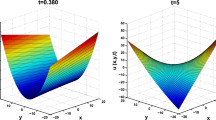Abstract
In this work, Lie symmetry method is employed to obtain invariant solutions of KP-BBM equation. It represents propagation of bidirectional small amplitude waves in nonlinear dispersive medium. The infinitesimal generators and their commutative relations are derived using invariance under one parameter transformation. These infinitesimal generators lead to reductions of KP-BBM equation into ODEs under two stages and thus exact solutions are constructed consisting several arbitrary constants. To analyze the physical phenomena, these solutions are expanded graphically with numerical simulation. Consequently, multisoliton, doubly soliton, compacton, soliton fusion, parabolic nature and annihilation profiles of solutions are demonstrated to validate these obtained results with physical phenomena and make the findings worthy.
Similar content being viewed by others
Avoid common mistakes on your manuscript.
1 Introduction
The study of nonlinear partial differential equations (NPDEs) are widely growing for its direct relevance with various physical phenomena like plasma physics, nonlinear optics, fluid mechanics, elastic media, optical fibers etc. [1,2,3,4,5,6,7,8,9,10,11,12]. Due to high nonlinear behavior, these NPDEs do not follow superposition principles and are difficult to be analyzed. To obtain their exact solution plays a vital role in understanding the phenomena physically. Therefore, a number of effective tools such as tanh method [1, 2], extended mapping method [3], bifurcation method [4, 5], Exp-function method [6], \((G^{'}/G)\)-expansion method [7], Hirota’s method [8, 9] and Lie symmetry method [10, 11, 13,14,15,16,17,18,19,20,21,22,23,24,25,26,27,28] have been evolved for reliable treatments of these NPDEs.
The motive with present study is to obtain invariant solutions of (2+1)-dimensional KP-BBM equation
where a, b, k are constants while u represents wave amplitude. It describes propagation of bidirectional small amplitude waves in nonlinear dispersive medium. The KP-BBM equation was first discovered by A.M. Wazwaz [1] by combining Kadomtsov- Petviashvili (KP) and Benjamin-Bona-Mahony (BBM) equations
\((u_t+auu_x+u_{xxx})_x+u_{yy}=0\) and \(u_t+u_x-a{(u^2)}_{x}-bu_{xxt}=0\) respectively. The KP equation is weakly two dimensional integrable generalization of unidirectional KdV equation [29]. It represents propagation of long waves and admits quadratic nonlinearity with dissipation [30]. While, BBM equation is unidirectional dispersive long-wave equation, known as associative KdV equation for small amplitude, long surface wave propagation. [31].
A.M. Wazwaz [1] investigated KP-BBM equation and its generalized form as well as derived some exact solutions using tanh and sine-cosine methods. Continuing, A.M Wazwaz [2] used extended tanh method to extract soliton solutions of Eq. (1.1). Some periodic wave solutions were found by M.A. Abdou [3]. Tang et al. [4] studied generalized KP-BBM equation and extracted soliton solutions with aid of bifurcation theory. Proceeding with same spirit, Song et al. [5] employed bifurcation method and listed some new soliton solution of Eq. (1.1). Moreover, some exact periodic solutions were constructed by Yu and Ma [6]. Alam and Akbar [7] proposed \((G^{'}/G)\)-expansion method and used it to derive travelling wave solutions of KP-BBM equation. Thereafter, Manafian et al. [8] used Hirota’s method to derive bilinear form of Eq. (1.1) and analyzed its stability. Proceeding with same methodology, Manafian et al. [9] described the intraction between solitons and lumps. Recently, Tanwar and Wazwaz [10] derived optimal system via Lie symmetries and generated some exact soliton solution of Eq. (1.1). Some more solutions were found by Kumar et al. [11]. Apart, Mekki and Ali [12] analyzed numerical results of KP-BBM equation using finite difference scheme and Crank-Nicholson method.
The above findings [1,2,3,4,5,6,7,8,9,10,11,12] motivate us to derive some exact solutions with aid of Lie point symmetries. The main idea of method is based on invariance under various symmetries. The method reduces the independent variables. Thus, repeated applications lead to determining ODEs, which result into exact solutions. These exact solutions describe doubly soliton, multisoliton, compacton, soliton fusion and parabolic nature. Solitons are localized solitary wave packets retaining their shapes when propagating with constant velocity. It is experimentally reported as result of balancing in dispersion effect and nonlinearity. Solitons are widely used in shallow water waves, long-distance transmission and optical switching device due to its high stability. The compactons are newly evolved class of solitons having compact support without exponential tails or wings [32]. It shows the completely elastic interaction behavior similar to solitons. Compactons have wide applications in super deformed nuclei, cluster in hydrodynamic models, inertial fusion and the fission of liquid drops. Substantially, the non elastic behavior of solitons are observed in some specific phenomena. It may show fusion of two or more solitons in one soliton as well as fission of one soliton into two or more.
The remaining paper is organized as: Sect. 2 deals with Lie symmetries. The exact invariant solutions are reported in Sect. 3. In Sect. 4, the obtained results are analyzed. The conclusions and remarks are furnished in the end.
2 Lie Symmetries
In this section, we aim to discuss about basic terminology to produce infinitesimal generators. For, one parameter transformations are
where \({\xi }^t\), \({\xi }^y\), \({\xi }^x\), \(\theta \) are corresponding infinitesimals to keep PDEs invariant.
The associated vector field is
Employing prolongation \(Pr^{(3)}(\Delta )=0\) on Eq. (1.1), the invariant surface is
where
with total derivatives \(D_t\), \(D_y\), \(D_x\).
Using these extensions in Eq. (2.1), we get desired infinitesimals
with real constants \(b_1\), \(b_2\), \(b_3\) and \(b_4\).
The symmetry analysis for Eq. (1.1) is associated with following vectors
The commutative relations of these vectors are given in Table 1, where \((i,j)^{th}\) entry of commutator table are represented by Lie brackets \([\alpha _i, \alpha _j]=\alpha _i\alpha _j-\alpha _j\alpha _i\).
The commutative table shows the closure property of vectors under Lie brackets.
3 Invariant Solutions
The auxiliary equation to determine invariant solutions is given as
Case (I): For \(b_4 \ne 0\), the Eq. (3.1) can be written as
with \(B_1=\frac{b_1}{b_4}\), \(B_2=\frac{b_2}{b_4}\) and \(B_3=\frac{b_3}{b_4}\). Then, the similarity form is
where similarity function \(P(\xi , \eta )\) consists of variables
Availing Eq. (3.2) into Eq. (3.1), we have first reduction as
Again applying STM on Eq. (3.3) , the infinitesimals are obtained as
Thus, characteristic equation is
It follows similarity form
with similarity variable \(\chi =\eta \). It transforms the Eq. (3.3) into
which has the solution \(\displaystyle P_1=c_1\,{\chi }^{\frac{1}{2}}+c_2\).
Thus, KP-BBM equation has solution
Case (II): For \(b_4 = 0\) and \(b_3 \ne 0\), the Eq. (3.1) can be written as
with \(B_4=\frac{b_1}{b_3}\) and \(B_5=\frac{b_2}{b_3}\).The similarity form yields
where \(P(\xi , \eta )\) is function of
The Eqs. (1.1) and (3.6) lead towards first reduction of KP-BBM equation
A particular solution of Eq. (3.7) is
Thus, solution of Eq. (1.1) is
To reduce Eq. (3.7) again, the characteristic equation is
Case (IIa): If \(b_6 \ne 0\), the above characteristic is rewritten as
such that \(\displaystyle P=P_1(\chi )\) with \(\chi =\xi -B_6\,\eta \) and \(B_6=\frac{b_5}{b_6}\).
Thus, Eq. (3.7) is transformed to
Taking \(B_4-B_5B_6=0\) and \(1+kB_6^2=0\), a particular solution is
Eventually, the solution of test equation is
Furthermore, the thrice integration of Eq. (3.10) provides
where \(B_7=\frac{2a}{3b(B_4-B_5B_6)}\) and \(B_8=\frac{1-B_4+B_5B_6-kB_6^2}{2a}\).
Some solutions of Eq. (3.12) are addressed as follows:
Case (II\(a_1\)): For \(c_9=3B_8\) and \(c_{10}=-B_8^3\) in Eq. (3.12), we have
which has a solution
So, the required solution is
Case (II\(a_2\)): For \(c_9=\frac{9B_8^2}{4}\) and \(c_{10}=0\) in Eq. (3.12), we have
The solution is
So, the required solution is
Also, another solution is
Case (II\(a_3\)): For \(c_9=0\) and \(c_{10}=0\) in Eq. (3.12), we have
Then, it raises the solution
So, the required solution is
Case (IIb): If \(b_6=0\), then Eq. (3.9) produces similarity function is \(P=P_1(\chi )\) with \(\chi =\eta \). So, Eq. (3.7) is converted to \(\bar{\bar{P_1}}=0\) and thus \(P_1=c_{15}\eta +c_{16}\).
Consequently, Eq. (1.1) gets the solution
Case (III): For \(b_2 = 0\), \(b_4 = 0\) and \(b_3 \ne 0\), the Eq. (3.1) is rewritten as
The similarity form yields
where \(P(\xi , \eta )\) is function of
The Eqs. (1.1) and (3.21) lead towards following reduction
A particular solution of Eq. (3.22) is
Thus, solution of Eq. (1.1) is
An another solution is
To reduce Eq. (3.22) again, the characterstic equation is
For \(b_7 \ne 0\), we have similarity form
Thus, Eq. (3.22) is transformed to
It has an exact solution
Consequently, the test equation has solution
Another solution of Eq. (3.26) is
Thus, the test equation has solution
4 Analysis of Results
Explicit expressions are much significant to interpret the phenomena physically. In this section, we analyze graphical behavior of the solutions (3.5), (3.8), (3.14), (3.16), (3.17), (3.19), (3.27) while the solutions listed in Eqs. (3.11), (3.20), (3.23), (3.24), (3.28) are self-evident. All the derived results are new and never reported before. These solutions involve free parameters therefore we perform the numerical simulation for significant values of existing parameters as \(a=0.6596\), \(b=0.5185\), \(k=0.9729\) and rest are given in adjacent figures. The figures show doubly soliton, multisoliton, compacton, soliton fusion and parabolic nature, which are analyzed as follows:
Soliton fusion for Eq. (3.5)
Parabolic nature of solution (3.8)
Figure 1: The non elastic behavior of solution (3.5) is expressed in this spatio-temporal profile, which shows soliton fusion for \(B_2=0.9516\), \(B_3=0.9203\), \(c_1=0.0526\), \(c_2=0.7378\). It is clearly exhibited in 2D view that solitons are fused when interacting with others and show new phenomenon.
Figure 2: It demonstrates the parabolic nature of the solution profile (3.8) at \(t=0.7093\). The values assigned to parameters are \(B_4=0.6489\), \(B_5=0.8003\), \(c_3=0.7546\), \(c_4=0.276\), \(c_5=0.6797\). With passes of time, nonlinearity disappears and results into straight stripe for \(t=100\).
Intensive multisoliton profile for Eq. (3.14)
Multisoliton annihilation profile for Eq. (3.16)
Figure 3: It displays the intensive feature of solitary waves interacting with each others. The values to remaining constants are provided as \(B_4=0.6489\), \(B_5=0.8003\), \(B_6=0.7546\), \(B_7=18.8491\), \(B_8=1.1839\), \(c_{11}=0.6537\). The velocity component u features minimum and maximum amplitude of multisoliton at \(t=0.1076\). The minimum amplitude of wave is displayed in the centre and maximum amplitude in sides in \(x-u\) and \(y-u\) views.
Figure 4: The multisoliton profile for Eq. (3.16) is analyzed in this figure for \(B_4=0.6489\), \(B_5=0.8003\), \(B_6=0.7546\), \(B_7=18.8491\), \(B_8=1.1839\), \(c_{12}=0.4538\) at \(t=0.4598\). The slowly decay in profile with time is concluded. As time is bigger than \(t=879\), the solitons annihilate and profile becomes stationary.
Elastic multisoliton for Eq. (3.17)
Compacton profile for Eq. (3.19)
Figure 5: The physical behavior of solution (3.17) is illustrated via this profile at \(t=0.3648\). It shows multisoliton nature for \(B_4=0.6489\), \(B_5=0.8003\), \(B_6=0.7546\), \(B_7=18.8491\), \(B_8=1.1839\), \(c_{13}=0.6256\). The solitons seem completely elastic during mutual collision except phase shift, and the maximum and minimum amplitude of waves is shown in \(y-u\) view.
Figure 6: The elastic compacton behavior of Eq. (3.19) is represented at \(t=0.6554\). The values to constants are assigned as \(B_4=0.6489\), \(B_5=0.8003\), \(B_6=0.7546\), \(B_7=18.8491\), \(B_8=1.1839\), \(c_{14}=0.1711\). The amplitude of compactons remains unchanged during interaction with others and show its elastic behavior when the argument of \(\cos \) lies in \((-\frac{\pi }{2}, \frac{\pi }{2})\) displayed in \(y-u\) view.
Transition of doubly soliton in single soliton for (3.27)
Figure 7: The transition of doubly soliton into single soliton with passage of time for Eq. (3.27) is recorded in this figure. It shows doubly soliton profile at \(t=0.2769\) for \(B_4=0.6489\), \(B_9=0.0462\), \(B_{10}=0.0971\). When time increases and passes over \(t=60\), the dynamical change happens in doubly soliton and transforms to single soliton.
5 Conclusions
In this work, Lie symmetry method is applied to construct infinitesimal generators, commutative relations and symmetry reductions of KP-BBM equation. The one parameter transformation enables to retain the invariance of PDEs under symmetry reductions. The twice reductions of KP-BBM equation provide determining ODEs and lead to exact solutions listed in Eqs. (3.5), (3.8), (3.11), (3.14), (3.16), (3.17), (3.19), (3.20), (3.23), (3.24), (3.27) and (3.28). All these results are novel and never reported earlier. Some of these results are examined graphically based on their numerical simulation. Eventually, mutisoliton, doubly soliton, compacton, soliton fusion and parabolic nature are analyzed to make these finding physically meaningful. Thus, Lie symmetry method may be treated as effective and versatile tool to derive exact solutions of highly nonlinear PDEs.
Data Availability Statement
All data analysed during this study are included and the manuscript has no associated data.
References
Wazwaz, A.M.: Exact solutions of compact and noncompact structures for the KP-BBM equation. Appl. Math. Comput. 169, 700–712 (2005)
Wazwaz, A.M.: The extended tanh method for new compact and noncompact solutions for the KP-BBM and the ZK-BBM equations. Chaos Solitons Fractals 38, 1505–1516 (2008)
Abdou, M.A.: Exact periodic wave solutions to some nonlinear evolution equations. Int. J. Nonlinear Sci. 6, 145–153 (2008)
Tang, S., Huang, X., Huang, W.: Bifurcations of travelling wave solutions for the generalized KP-BBM equation. Appl. Math. Comput. 216, 2881–2890 (2010)
Song, M., Yang, C., Zhang, B.: Exact solitary wave solutions of the Kadomtsov-Petviashvili-Benjamin-Bona-Mahony equation. Appl. Math. Comput. 217, 1334–1339 (2010)
Yu, Y., Ma, H.C.: Explicit solutions of (2+1)-dimensional nonlinear KP-BBM equation by using Exp-function method. Appl. Math. Comput. 217, 1391–1397 (2010)
Alam, M.N., Akbar, M.A.: Exact traveling wave solutions of the KP-BBM equation by using the new approach of generalized \((G^{^{\prime }}/G)\)-expansion method. Springer Plus 2, 617 (2013)
Manafian, J., Ilhan, O.A., Alizadeh, A.: Periodic wave solutions and stability analysis for the KP-BBM equation with abundant novel interaction solutions. Phys. Scripta 95, 065203 (2020)
Manafian, J., Murad, M.A.S., Alizadeh, A., Jafarmadar, S.: M-lump, interaction between lumps and stripe solitons solutions to the (2+1)-dimensional KP-BBM equation. Eur. Phys. J. Plus 135, 167 (2020)
Tanwar, D.V., Wazwaz, A.M.: Lie symmetries, optimal system and dynamics of exact solutions of (2+1)-dimensional KP-BBM equation. Phys. Scripta 95, 065220 (2020)
Kumar, S., Kumar, D., Kharbanda, H.: Lie symmetry analysis, abundant exact solutions and dynamics of multisolitons to the (2+1)-dimensional KP-BBM equation. Pramana-J. Phys. 95, 33 (2021)
Mekki, A., Ali, M.M.: Numerical simulation of Kadomtsev-Petviashvili-Benjamin-Bona-Mahony equations using finite difference method. Appl. Math. Comput. 219, 11214–11222 (2013)
Rosenau, P., Hyman, J.M.: ompactons: solitons with finite wavelength. Phys. Rev. Lett. 70, 564–567 (1993)
Hammack, D., McCallister, N., Schener, N., Segur, N., Schener, H.: Two-dimensional periodic waves in shallow water. II. Asymmetric waves. J. Fluid Mech. 285, 95–122 (1995)
Kadomtsev, B.B., Petviashvili, V.I.: On the stability of solitary waves in weakly dispersive media. Sov. Phys. Dokl. 15, 539–541 (1970)
Benjamin, T.B., Bona, J.L., Mahony, J.J.: Model equations for long waves in nonlinear dispersive systems. Philos. Trans. R. Soc. Land. Ser. A 272, 47–78 (1972)
Bluman, G.W., Cole, J.D.: Similarity Methods for Differential Equations. Springer-Verlag, New York (1974)
Olver, P.J.: Applications of Lie Groups to Differential Equations. Springer-Verlag, New York (1993)
Ma, H.C.: Generating Lie point symmetry groups of (2+1)-dimensional Broer-Kaup equation via a simple direct method. Commun. Theor. Phys. 43, 1047–1052 (2005)
Lou, S.Y., Ma, H.C.: Finite symmetry transformation groups and exact solutions of Lax integrable systems. Chaos Solitons Fractals 30, 804–821 (2006)
Lou, S.Y., Ma, H.C.: Non-Lie symmetry groups of (2+1)-dimensional nonlinear systems obtained from a simple direct method. J. Phys. A. Math. Gen. 38, L129–L137 (2005)
Kumar, M., Tanwar, D.V., Kumar, R.: On closed form solutions of (2+1)-breaking soliton system by similarity transformations method. Comput. Math. Appl. 75, 218–234 (2018)
Kumar, M., Tanwar, D.V., Kumar, R.: On Lie symmetries and soliton solutions of (2+1)-dimensional Bogoyavlenskii equations. Nonlinear Dyn. 94, 2547–2561 (2018)
Kumar, M., Tanwar, D.V.: On Lie symmetries and invariant solutions of (2+1)-dimensional Gardner equation. Commun. Nonlinear Sci. Numer. Simul. 69, 45–57 (2019)
Kumar, M., Tanwar, D.V.: Lie symmetry reductions and dynamics of solitary wave solutions of breaking soliton equation. Int. J. Geom. Methods Mod. Phys. 16, 1950110 (2019)
Kumar, M., Tanwar, D.V.: On some invariant solutions of (2+1)-dimensional Korteweg-de Vries equations. Comput. Math. Appl. 76, 2535–2548 (2018)
Kumar, M., Tanwar, D.V.: Lie symmetries and invariant solutions of (2+1)-dimensional breaking soliton equation. Pramana-J. Phys. 94, 23 (2020)
Tanwar, D.V., Wazwaz, A.M.: Lie symmetries and dynamics of exact solutions of dissipative Zabolotskaya-Khokhlov equation in nonlinear acoustics. Eur. Phys. J. Plus 135, 520 (2020)
Polat, G.G., Özer, T.: The group-theoretical analysis of nonlinear optimal control problems with hamiltonian formalism. J. Nonlinear Math. Phys. 27, 106–129 (2020)
Li, J., Zhou, Y.: Exact solutions in invariant manifolds of some higher-order models describing nonlinear waves. Qual. Theory Dyn. Syst. 18, 183–199 (2019)
Chang, L., Liu, H., Zhang, L.: Symmetry reductions, dynamical behavior and exact explicit solutions to a class of nonlinear shallow water wave equation. Qual. Theory Dyn. Syst. 19, 35 (2020)
Tanwar, D.V.: Optimal system, symmetry reductions and group-invariant solutions of (2+1)-dimensional ZK-BBM equation. Phys. Scr. 96, 065215 (2021)
Author information
Authors and Affiliations
Ethics declarations
Conflict of interest
The authors declare that they have no conflict of interest.
Additional information
Publisher's Note
Springer Nature remains neutral with regard to jurisdictional claims in published maps and institutional affiliations.
Rights and permissions
About this article
Cite this article
Tanwar, D.V., Ray, A.K. & Chauhan, A. Lie Symmetries and Dynamical Behavior of Soliton Solutions of KP-BBM Equation. Qual. Theory Dyn. Syst. 21, 24 (2022). https://doi.org/10.1007/s12346-021-00557-8
Received:
Accepted:
Published:
DOI: https://doi.org/10.1007/s12346-021-00557-8











